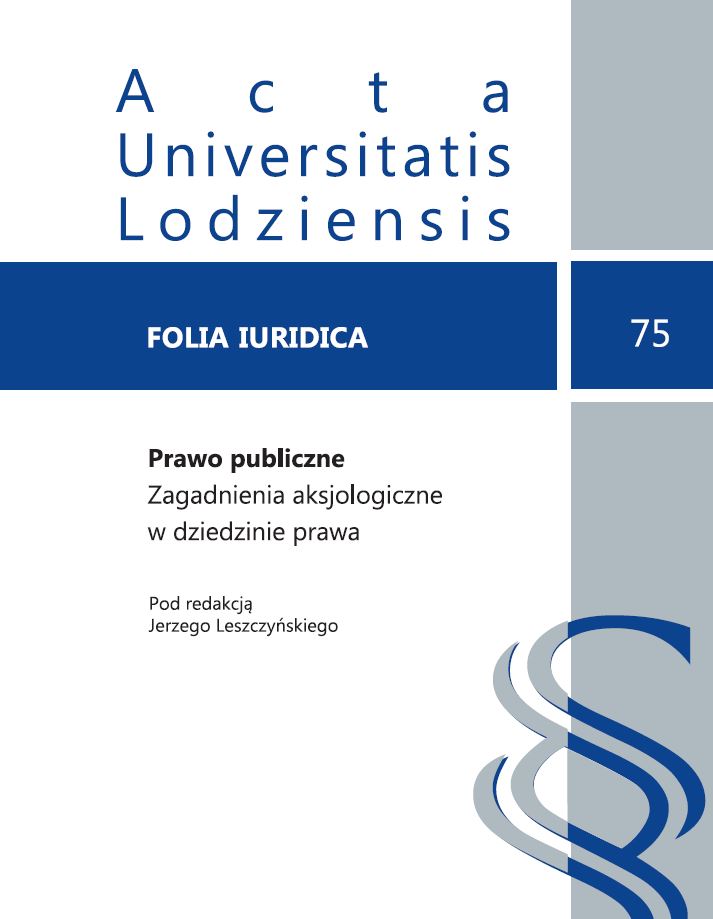Metaphorical reasoning
DOI:
https://doi.org/10.18778/0208-6069.75.14Keywords:
law, metaphor, persuasion, metaphorical reasoningAbstract
That metaphors are a part of law seems to be commonplace nowadays. Nevertheless, the extent of their influence is not commonly acknowledged. The three types of metaphors: (1) verbal, point metaphors, (2) systemic, thinking changing, model metaphors and (3) hidden systemic, conceptual metaphors are here associated with the distinction between what is said and how it is said and between a conscious and unconscious message delivery – all of them of particular relevance to a legal discourse. Not all types of metaphors can (and should) be dispensed with. In some negative cases the only way to reduce their adverse effects is to provide tools to detect them. The definition proposed may serve this purpose. As an illustration, the paper points to some ordinary situation giving rise to metaphoric reasoning which leads to quite unpredictable (misleading) conclusions.
Downloads
References
Black Max. 1962. Metaphor. W Models and Metaphors. Red. Ortony Andrew. 25–48. Ithaca–NewYork: Cornell University Press.
Google Scholar
Black Max. 1962. Models and Archetypes. W Models and Metaphors. Red. Ortony Andrew. 219–243. Ithaca–New York: Cornell University Press.
Google Scholar
Bosmajian Haig. 1992. Metaphor and Reason in Judicial Opinions. Carbondale: Southern Illinois University Press.
Google Scholar
Bowers John Waite, Osborn Michael. 1981. „Attitudinal Effects of Selected Types of Concluding Metaphors in Persuasive Speeches”. Speech Monographs 33: 147–155.
Google Scholar
Cunningham-Parmeter Keith. 2011. „Alien Language: Immigration Metaphors and the Jurisprudence of Otherness”. Fordham Law Review 79: 15–45.
Google Scholar
Craig Rotherham. 2002. Proprietary Remedies in Context. Oxford: Bloomsbury Publishing.
Google Scholar
Crisp Richard, Turner Rhiannon. 2014. Essential Social Psychology. Thousand Oaks, CA: Sage Publications.
Google Scholar
Davison Phillips. 1983. „The Third-person Effect in Communication”. Public Opinion Quarterly 47 (1): 1–15.
Google Scholar
Grice Herbert Paul. 1977. „Logika i konwersacja”. Przegląd Humanistyczny 21 (6): 85–99.
Google Scholar
Hazel Marcus, Zajonc Robert B. 1985. The Cognitive Perspective in Social Psychology. W The Handbook of Social Psychology. Red. Lindzey Gardner, Aronson Elliot. 137–229. New York: Random House.
Google Scholar
Hofstadter Douglas R. 2001. Analogy as the Core of Cognition. W The Analogical Mind: Perspectives from Cognitive Science. Red. Genter Dedre, Holyoak Keith James, Kokinov Boicho N. 499–538. Cambridge, MA: MIT Press.
Google Scholar
Johnson Joel T., Taylor Sheley. E. 1981. „The Effect of Metaphor on Political Attitudes”. Basic and Applied Social Psychology 2: 305–316.
Google Scholar
Kelling George. 1991. „Crime and Metaphor: Toward a New Concept of Policing”. City Journal 1. www.city-journal.org/html/issue1_5.html (dostęp: 8.11.2015).
Google Scholar
Kotuk Tadeusz. 2012. „Metafory w polskim dyskursie prawniczym z perspektywy lingwistyki kognitywnej” Przegląd Sądowy 10. www.polaczenie-spolek.wolterskluwer.pl/artykuly-prawnicze/metafory-w-polskim-dyskursie-prawniczym-z-perspektywy-lingwistyki-kognitywnej,264.html (dostęp: 7.03.2015).
Google Scholar
Kövecses Zoltán. 2005. Metaphor in Culture: Universality and Variation. Cambridge: University Press.
Google Scholar
Lakoff George, Johnson Mark. 1988. Metafory w naszym życiu. tł. Krzeszowski Tomasz P. Warszawa: Państwowy Instytut Wydawniczy.
Google Scholar
Lakoff George. 2008. Women, Fire, and Dangerous Things. Chicago: University of Chicago Press.
Google Scholar
Larsson Stefan. 2013. Justice ‘Under’ Law: The Bodily Incarnation of Legal Conceptions Over Time. www.soclaw.lu.se/en/stefanlarsson/publication/4178656 (dostęp: 22.03.2015).
Google Scholar
Pawłowski Tadeusz. 1978. Tworzenie pojęć i definiowanie w naukach humanistycznych. Warszawa: Państwowe Wydawnictwo Naukowe.
Google Scholar
Percy Elise J., Hoffman Joseph L., Sherman Steven J. 2011. „Sticky Metaphors and the Persistence of the Traditional Voluntary Manslaughter Doctrine”. Journal of Law Reform 44 (2): 383–427.
Google Scholar
Rotherham Craig. 2002. Proprietary Remedies in Context. Oxford, Portland: Hart Publishing.
Google Scholar
Rybarkiewicz Dorota. 1998. „The Structure of Metaphor: Towards a Pragmatic Approach”. Logica Trianguli 2: 103–115.
Google Scholar
Rybarkiewicz Dorota. 2015. Out of the Box Thinking. W Cognition, Meaning and Action. Red. Łukowski Piotr, Gemel Aleksander, Żukowski Bartosz. 146–159. Łodź–Kraków: Łódź University Press & Jagiellonian University Press.
Google Scholar
Schön Donald A. 1994. Generative metaphor: A perspective on problem-setting in social policy. W Metaphor and Thought. Red. Ortony Andrew. 137–163. Cambridge: University Press.
Google Scholar
Searle John R. 1994. Metaphor. W Metaphor and Thought. Red. Ortony Andrew. 92–124. Cambridge: University Press.
Google Scholar
Smith Michael R. 2007. „Levels of Metaphor in Persuasive Legal Writing”. Mercer Law Review 58: 919–948.
Google Scholar
Sopory Pradeep, James Price Dillard. 2002. Figurative Language and Persuasion. W The Persuasion Handbook: Developments in Theory and Practice. Red. Dillard James Price, Pfau Michael. 407–426. Thousand Oaks, CA: Sage Publications.
Google Scholar
Sperber Dan, Wilson Deirdre. 1986. Relevance: Communication and Cognition. Oxford: Basil Blackwell.
Google Scholar
Thibodeau Paul H., Boroditsky Lera. 2011. Metaphors we Think With: The Role of Metaphor in Reasoning. http://journals.plos.org/plosone/article?id=10.1371/journal.pone.0016782 (dostęp: 6.04.2015).
Google Scholar
Wilkins Pamela A. 2012. „Confronting the Invisible Witness: The Use of Narrative to Neutralize Capital Jurors’ Implicit Racial Biases”. West Virginia Law Reviev 115: 305–362.
Google Scholar
Downloads
Published
How to Cite
Issue
Section
License
Copyright (c) 2015 © Copyright by Uniwersytet Łódzki, Łódź 2015

This work is licensed under a Creative Commons Attribution-NonCommercial-NoDerivatives 4.0 International License.













